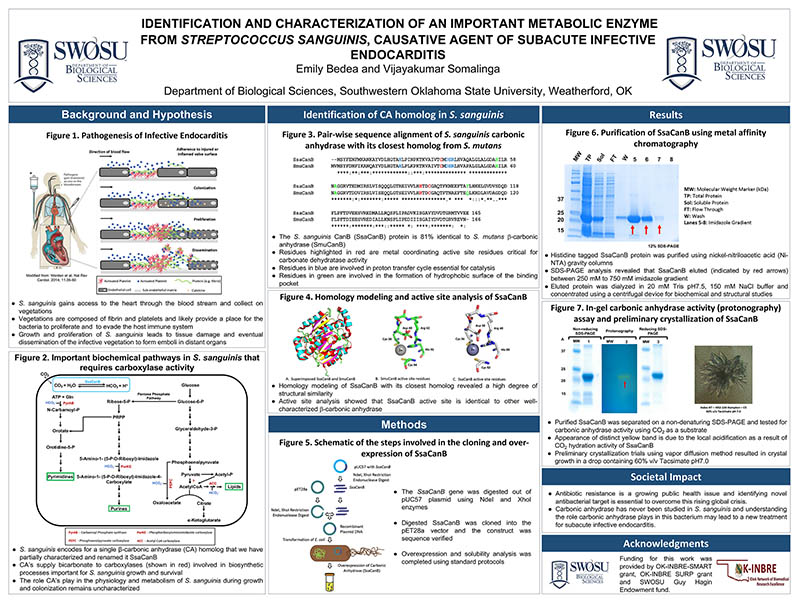
Hover to pan and click to magnify. Click again to pan at full screen.
Emily Bedea, Dept. of Biological Sciences, Southwestern Oklahoma State University, Weatherford, OK. Faculty Advisor, Dr. Vijay Somalinga, Southwestern Oklahoma State University, Weatherford, OK.
Emily Bedea, Dept. of Biological Sciences, Southwestern Oklahoma State University, Weatherford, OK. Faculty Advisor, Dr. Vijay Somalinga, Southwestern Oklahoma State University, Weatherford, OK.
ABSTRACT
In the United States, approximately 40,000 people will get diagnosed with subacute infective endocarditis (SIE) this year. A leading cause of this infection is a bacterium called Streptococcus sanguinis, which is present in the mouths of most of the human population. In certain populations, these bacteria can invade the heart valves and is the leading cause of SIE. Endocarditis is the inflammation of the heart and heart valves. Infective endocarditis, specifically, is the inflammation of the heart or heart valves due to bacteria. Bacteria can enter the bloodstream following everyday activities and can establish itself in the heart. Once bacteria invade the heart valves, it causes the heart valves to erode and commonly leads to heart failure. Without treatment, infective endocarditis is always fatal, and even with current treatment, patients have a mortality rate as high as 20%. Previous studies have focused on how the bacteria is able to attach to the surface of the heart, and the proteins that aid in this attachment have been well characterized. However, little is understood about how S. sanguinis can survive in these harsh conditions long enough to establish an infection. The protein carbonic anhydrase is an important metabolic enzyme that helps synthesize cellular components essential to the maintenance and survival of this bacterium. In addition to this, inactivating the protein carbonic anhydrase in other pathogens has been shown to decrease the bacteria’s ability to cause infection. We hypothesize that inactivating the gene that produces the protein carbonic anhydrase would prevent S. sanguinis from causing the deadly disease. I used computational methods, to find the specific DNA that coded for carbonic anhydrase in S. sanguinis. The gene was synthesized, and I used standard methods to clone the gene in order to obtain pure protein. After some testing, I was able to demonstrate that the protein derived from the synthesized gene has carbonic anhydrase activity. Both the computational studies and lab studies led to the conclusion that my protein was a carbonic anhydrase. In the future, I would like to study the structure of my protein so an inhibitor can be found.

DISQUS COMMENTS WILL BE SHOWN ONLY WHEN YOUR SITE IS ONLINE